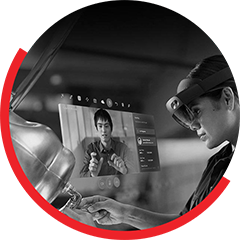From Analysts to Operators, the vote is in: Augmented Reality has arrived in the Energy Sector
Augmented Reality, or AR, is known to most as the less glamorous sibling of virtual reality. However, as virtual reality shifts into the consumer market targeting the gamer world, AR steps into the spotlight as a business tool many companies are employing. AR has become a part of enterprise workforce training. It simulates on-the-job experience and offers performance support to better train employees for when they are in real-time situations. The implementation of AR technology in the oil and gas and field services industries has proven to companies and their employees that it is a smart asset to invest in. More and more companies are realizing the wide array of benefits that AR technology offers. IDC predicts that 25 percent of field service techs will use augmented reality by 2020.
ABI Research expects that the total augmented reality market revenues for the energy and utility industries will grow up to $18 billion by 2022. Companies including Chevron, British Petroleum, and General Electric are among the businesses paving the path for AR. Baker Hughes, a GE Oil Company, is using an AR Smart Helmet in the field. It is a safety helmet with a visor that can display photos, video streaming, and schematics. It has wireless headphones and a microphone attached to the helmet, as well as a wireless helmet camera so engineer experts can provide assistance. RealWear also has AR hard hats with clients including Shell, Volkswagen, State Grid, Airbus, Walmart, and Lexus. It also recently announced an $80 million Series B equity and debt round spearheaded by Teradyne, and companies including Bose, JP Morgan Chase, Qualcomm, and Kopin Corporation also participated.
Microsoft HoloLens 2 for Oil and Gas Services
Smart glasses are another augmented reality initiative taking the oil and gas and field services industry by storm. BP is one of the major companies that has implemented smart glasses into their workforce. They have adopted a software platform created by the Israeli company Fieldbit. Technicians in field service use this technology through AR glasses, mobile devices, and web browsers. Another set of smart glasses taking the industry by storm is the Microsoft Hololens 2. The Hololens has been used by the U.S. military as well as Airbus since the first edition of the glasses, and now Mattel and Buick are beginning to use the new and improved smart glasses in their own business processes.
The Hololens was designed specifically to be sold to corporations for front-line workers, not consumers. It has new and revamped technology with a wider field of view, higher comfort level, flip-up visor, artificial intelligence tools, manipulation of holographs, and eye-tracking. Eye-tracking can measure eye movement and can be used to directly interact with virtual objects.
As the largest commercial cloud business in the world, with over $38 billion of revenue, Microsoft is making a point to connect its new Hololens with the cloud. With the new Hololens, Microsoft collaborated with Spatial to allow isolated users to meet in a virtual meeting room as 3D avatars. In the meeting room, users can interact with one another and the AR space with touch and voice commands. The avatars are designed to allow users to work as if they are face to face. With the Microsoft Dynamics 365 layout app, the objects will be saved through the cloud and available at a location, cloud anchor, where all users can access the document on any device. Users can then go into it at different times to edit or leave notes on documents or objects. Mattel, a toy manufacturer, and Trimble, a logistics firm, are already using this feature in their companies.

With smart glasses and helmets, companies can change the way they operate. With AR, companies can improve how they train and educate their employees. Technicians can use their AR device to access operating and repair procedures, as well as service instructions. The AR device can then display an overlay of the instructions on the environment and break down tasks into an easy-to-understand, step-by-step process. Additionally, technicians can be trained while accomplishing a task, which can be referred to as “in situ” training. Along with instructive AR capabilities, this technology has remote service capabilities.
Remote Service Capabilities
Through the device, technicians can call engineer experts and have the expert guide them through procedures of maintenance, inspection, repairs, or setups. This allows companies to be more cost and time-efficient. Crucial issues are addressed immediately with no downtime and companies do not have to pay costly fees to send an expert out to an oil rig. AR can also provide employees with simulated pre-made training scenarios. These training sessions can improve knowledge retention and cut traditional training costs. They provide realistic training for dangerous situations, which can test employees’ safety protocols as well as develop their execution of procedures in the event of an emergency.

